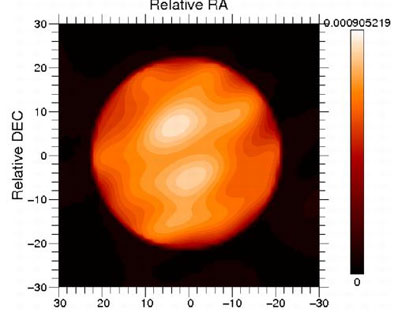




|

|

Unprecedented details seen on the surface of Betelgeuse
L'OBSERVATOIRE DE PARIS RELEASE
Posted: January 12, 2010


Using interferometry, an international team led by an astronomer of Paris Observatory (LESIA) obtained an unprecedented image of the surface of the red supergiant Betelgeuse, in the constellation of Orion. The image reveals the presence of two giant bright spots, whose size is equivalent to the Earth-Sun distance: they cover a large fraction of the surface. It is a first strong and direct indication of the presence of the convection phenomenon, transport of heat by moving matter, in a star other than the Sun. This result allows us to better understand the structure and the evolution of supergiants.

The surface of Betelgeuse in near infrared at 1.64 micron in wavelength, obtained with the IOTA interferometer. Credit: 2010 Haubois / Perrin (LESIA, Observatoire de Paris)
|
Betelgeuse is a red supergiant located in the constellation of Orion.
This star is quite different from our Sun: 600 times larger in
dimension, it radiates approximately 100,000 times more energy. But
following the Sun, this type of object also reveals a surface with
bright and dark spots, i.e., hotter and colder spots. These structures
would be mainly due to the phenomenon of convection, i.e., the
transport of heat by matter currents. This phenomenon is observed
every day in boiling water. On the surface of the Sun, these spots are
rather well-known and visible. However, it is not at all the case for
other stars and in particular supergiants. The size, physical
characteristics, and lifetime of these dynamical structures remain
unknown.
Betelgeuse is a good target for interferometry because its size and
brightness make it easier to observe. Using simultaneously the three
telescopes of the Infrared Optical Telescope Array (IOTA)
interferometer on Mount Hopkins in Arizona (removed since then), the
team partly formed by three researchers from Paris Observatory could
obtain a great number of high-precision measurements. These made it
possible to reconstruct an image of the star surface thanks to two
algorithms. A small number of computer programs are used by the few
astronomers who use astronomical interferometry to produce images.
Here, two different algorithms gave the same image. One was created by
Eric Thiebaut from the Astronomical Research Center of Lyon (CRAL) and
the other was developed by Laurent Mugnier and Serge Meimon from
ONERA. The final image reveals the star surface with unprecedented
fine details. Two bright spots clearly show up next to the center of
the star.
Other images of less quality of Betelgeuse's surface had already been
obtained in the past. They were primarily models of the surface
constrained from interferometric data. Now, the researchers have a
true image whose richness exceeds what is possible to imagine from a
model. For the first time, one can say that two spots are present and
determine the size of the largest. Perhaps this difference in
dimension corresponds to different physical phenomena.
The analysis of the brightness of the spots shows a variation of 500
degrees compared to the average temperature of the star (3,600
Kelvins). The largest of the two structures has a dimension equivalent
to the quarter of the star diameter (or one and a half the Earth-Sun
distance). This marks a clear difference with the Sun where the
convection cells are much finer and reach hardly 1/20th of the solar
radius (a few Earth radii). These characteristics are compatible with
the idea of luminous spots produced by convection. These results
constitute a first strong and direct indication of the presence of
convection on the surface of a star other than the Sun.
Convection could play an important role in the explanation of the
mass-loss phenomenon and in the gigantic plume of gas that is expelled
from Betelgeuse. The latter has been discovered by a team led by
Pierre Kervella from Paris Observatory. Convection cells are
potentially at the origin of the hot gas ejections. A new research
field is opening. This has been made possible thanks to Paris
Observatory researchers who now take advantage of their mastery in
interferometry on the largest telescopes in the world: Keck I and II,
Gemini, the Canada-France-Hawaii Telescope, and the European Very
Large Telescope.
|

|

|

|

|



